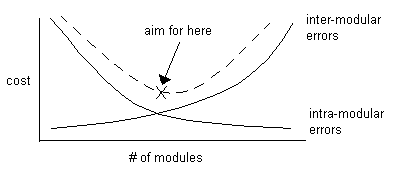
CIS 375 SOFTWARE ENGINEERING
University Of Michigan-Dearborn
Dr. Bruce Maxim, Instructor
System Design:
Characteristics Of Conceptual Design:
Technical Design Contents:
Design Approaches:
OR
Program Design:
Program Design Modules:
Program Design Guidelines:
vs.
(There are risks and benefits for both)
What Is A Module?
A set of contiguous program statements with:
(Self contained, sometimes can be compiled separately)
Modules either contain executable code or creates data.
Determining Program Complexity:

{More modules - less errors in each, but more errors between them}
Program Complexity Factors:
(too many lines of code between uses of a variable)
(too many lines of code in one module)
(too many "if - then - else", etc.)
(too much information to have to know)
(x,y -> x,y; not y1,y2)
(good presentation)
Software Reliability:
R = MTBF / (1 + MTBF)
0 < R < 1
A = MTBF / (MTBF + MTTR)
M = 1 / (1 + MTTR)
Mt = # of modules in current release.
Fc = # of changed modules.
Fa = # of modules added to previous release.
Fd = # of modules deleted from previous release.
SMI = [MT – (Fa + Fc + Fd)] / Mt
{As number of errors goes to 1 - software becomes more stable}
Estimating # Of Errors:
(s / S) = (n / N)
E(1) = (x / n) = (# of read errors found / total # of real errors)= q/y =
(# overlap/# found by 2)
E(2) = (y / n) = q/y = (# overlap / # found by 1)
n = q/(E(1) * E(2))
x = 25, y = 30, q = 15
E(1) = (15 / 30) = .5
E(2) = (15 / 25) = .6
n = [15 / (.5)(.6)] = 50 errors
confidence in software:
N = # of actual errors.
C (confidence level) = 1 if n > N
C (confidence level) = [S / (S – N + 1)] if n £ N
C = 1 if n > N
C = S / (S + N + 1)
S = # of seeded errors
s = # seeded errors found
N = # of actual errors
n = # of actual errors found so far
intensity of failure:
duty time
function A 90%
function B 10%
Suppose 100 total errors
50 in A, 50 in B
(.9)50K + (.1)50K = 50K
(.1)50K = 5K
or
(.9)50k = 45K
failures to time t = ae-b(t)
[(ln (failures / (0.5 + failures)) / (ln (0.5 + failures) / (test + failures))] * (test hours to last failure)
Example:
33,000 line program.
15 = errors found.
500 = # of hours total testing.
50 = # of hours since last failure.
if we need failure rate 0.03 / 1000 LOC
failure = (.03)(33) = 1
[(ln (1 / (0.5 + 1))) / (ln ((0.5 + 1) / 15) + 1)] * 450 = 77 Software Quality:
McCall's software quality functions (regression)

Software Quality Measurement Principles:
Attributes Of Effective Software Metrics:
Sample Metrics:
RE / FuP
(< 0.7) function strong applications.
(> 1.5) data strong applications.
Specification Quality Metrics:
nn = nf + nnf
where:
nn = requirements & specification .
nf = functional .
nnf = non-functional .
Specificity, Q1 = nai/qr
nai = # of requirements with reviewer agreement.
Completeness, Q2 = nu / (ni * ns)
nu = unique functions.
ni = # of inputs.
ns = # of states.
Overall completeness, Q3 = nc / (nc + nnv)
nc = # validated & correct.
nnv = # not validated.
Software Quality Indices:
IEEE standard - SMI (Software Maturity Index)
SMI = [Mt = (Fa + Fc + Fd)]/Mt
Mt = number of modules in current release.
Fa = modules added.
Fc = modules changed.
Fd = modules deleted.
Component Level Metrics:
Data slice.
Data tokens.
Glue tokens.
Super glue tokens.
Stickiness.
For data & control flow coupling.
For global coupling.
For environmental coupling.